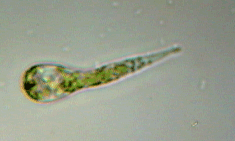
 HARWICH PORT - (08/25/04) Harbormaster Tom Leach took quick notice of a mysterious green
cloud in the waters off the bulkhead at Saquatucket Harbor. On this brisk late August
morning, when many boaters have already called it quits for the season, a bright emerald
plume shows itself from beneath the west dock. The anti-freeze colored plume is
mysteriously moving east with the
freshwater current that dumps in from Carding Machine brook and forces its way into the harbor from it's Northwest
corner.
He, and police chief Bill Mason who was visiting the harbormaster on an unrelated matter,
look a little more closely .and notice tiny fish, shiners Cyprinella spiloptera, insectivores
that can tolerate moderate water quality, having a free for all apparently feeding on the
cloud of inky green water. Chasing the shiners is a diving duck. Three levels of the food
chain grazing right in front of their eyes.
HARWICH PORT - (08/25/04) Harbormaster Tom Leach took quick notice of a mysterious green
cloud in the waters off the bulkhead at Saquatucket Harbor. On this brisk late August
morning, when many boaters have already called it quits for the season, a bright emerald
plume shows itself from beneath the west dock. The anti-freeze colored plume is
mysteriously moving east with the
freshwater current that dumps in from Carding Machine brook and forces its way into the harbor from it's Northwest
corner.
He, and police chief Bill Mason who was visiting the harbormaster on an unrelated matter,
look a little more closely .and notice tiny fish, shiners Cyprinella spiloptera, insectivores
that can tolerate moderate water quality, having a free for all apparently feeding on the
cloud of inky green water. Chasing the shiners is a diving duck. Three levels of the food
chain grazing right in front of their eyes.
The harbormaster has his assistant Heinz Proft, a marine biologist by training, draw a sample of the anti-freeze colored cloud for examination. They already know that this is not the result of a leaking cooling system from a boat. A bare droplet of the seawater under the microscope shows a slide teaming with life. Hundreds of amazingly active tear shaped single celled chlorophyll filled chloroplasts are darting and moving. They seeming have a tail to give the elongated "ocillating body" some means of propulsion. A quick e-mail to Terry O'Neill Marine Fisheries Phytoplankton Monitoring Program coordinator gets them the answer to questions of the "what and who" that they are not gathering from the field guides. It is marine euglena.
Tom and Heinz both now believe that a similar fall bloom which, neighbors may remember, ocurred simultaneously in Allen Harbor and Wychmere Harbor three years ago was the result of blooming of the same harmless protozoan specie.
Euglena is a well-known genus of flagellate protozoa, typical of the euglenids, and commonly found in nutrient-rich freshwater, with a few marine species. The cells vary in length from around 20 to 300 Ám, and are typically cylindrical, oval, or spindle-shaped, with many bright green chloroplasts and a single emergent flagellum. Euglena was first named by Ehrenberg in 1830, and since then over 100 species have been described. The name comes from the Greek words eu and ''gl ne, or good eye'', referring to the light-sensitive eyespot.

(above) TV monitor shows sample of the protozoan marine euglena taken from Saquatucket Harbor today
Allen Harbor October 2001 Euglena Bloom
Kingdom: PROTISTA Algal blooms are one of the more insidious consequences of eutrophication. In addition to being unsightly and smelly, masses of blue-green algae can literally choke the life out of a lake or pond by depriving it of much needed oxygen. In a harbor or estuarysimilar blooms will stress all marine organisms.
This may seem like something of a paradox - since algae undergoes photosynthesis, it should produce more oxygen than it consumes. However, after large concentrations of algae have built up, aerobic processes such as respiration and the decomposition of dead algal cells becomes increasingly significant. Under extreme conditions a eutrophic lake or pond may be left entirely devoid of fish. In an open system estuary, it is uptaken by all invertebrates and concentrated in the gut and gills, tainting clams, quahogs, mussels and oysters. These bi-valves often have to fight there way through low oxygen during periods of resperation of the primitive algae or chlorophyll ladened protozoan. The die-off of the bloom takes the DO level down even further making life for any organisms that can live through it a struggle. This is natural selection at its best as species as flounder, blue crabs, etc. are weeded out. Unfortunately then the estuary, as our harbors which need to double as the great nursery ground of the ocean are in trouble.
It was a little over a year ago that the board of health took its Allen Harbor pollution abatement education program on the road, making a presentation before 35 members of the Allen Harbor Yacht Club.
There were skeptics in the audience who found it hard to swallow that raccoon scat in the marshes above the harbor is the major source of bacterial pollution that reaches dangerously high levels each summer, causing shellfish closures.
But that was the finding of a nearly $50,000 study conducted by Stearns and Wheler, Inc., an environmental consulting firm based in Barnstable.
However, that study was target for sources of fecal coliform and did not touch on the over whelming nitrogen and small amounts of phosphate, and just the right amount of sunlight, in the estuary that trigger these blooms.
(Special report of the Harwich Natural Resources Department, Harwich, Mass 8/25/04)


autotrophic forms:
Division: Euglophyta - euglenoid flagellates